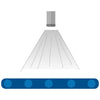The Importance of Using and Removing Solder Flux

What is Flux?
Flux is a chemical cleaning agent commonly used in soldering. It prepares the metal surfaces for soldering by removing oxides and impurities from the Printed Circuit Board (PCB). It can be used before to prep the surface, or during the soldering process to prevent further oxidization of the solder joint or surface. Oxidation may inhibit the formation of good solder joints. Another benefit of using flux is that it allows the molten solder to flow smoothly by altering the surface tension of molten solder, ensuring a more comprehensive coverage and stronger solder joints.
Why use Flux?
The oxides and impurities from metal surfaces may cause uneven or inadequate solder joints. The oxides present, together with exposure of solder to air, can also cause oxidation, which inhibits the formation of good solder joints. Weak joints may crack over time, resulting in poor conductivity of the circuit board.
Methods of Applying Flux
 |
Spraying For wave soldering, the flux has a higher solvent-to-flux proportion and is sprayed on the board prior to it going through the solder wave. The flux then clean the components that are to be soldered to remove any oxide layers that have formed. Depending on the level of corrosiveness of the flux, the board may require a pre-cleaning before the flux is applied. |
 |
Solder Paste Solder Paste is a thick paste made of solder flux and tiny spherical balls of metal solder. Commonly used for reflow soldering, the paste holds both the components and the solder in place while the heat of the reflow oven melts the solder balls, joining the components to the PCB. |
 |
Selective Application For PCBs that requires selective flux application, manual spraying, drop jet, or a flux pen can be used to accurately apply flux to specific areas. |
Importance of Removing Flux
Despite the benefits of using flux for soldering, it is crucial to remove flux residue (the leftover flux) from the PCB once the soldering is complete. Flux residue left on the PCB not only looks bad aesthetically, but more importantly, it could cause current leakage, resulting in low voltage and potential short circuits.
Methods of Removing Flux
- Rosin Based: These fluxes requires specific chemical solvents that typically involve fluorocarbons for removal.
- Water Soluble: Many cleaning agents, such as deionized water and detergents, can be used for water-soluble fluxes.
- No-Clean Flux: While no-clean fluxes typically require little to no cleaning, residual flux could still reduce the adhesion effectivity of conformal coatings. Therefore, it is recommended to remove it with a "No-Clean Flux" remover.
Any form of residue left on a PCB poses a risk as it could interfere with conductivity, especially with sensitive electrical components. As such, it is always best to remove flux residue and keep the PCB surface clean as much as possible. Click here to check out our series of Flux Removers by Techspray!
